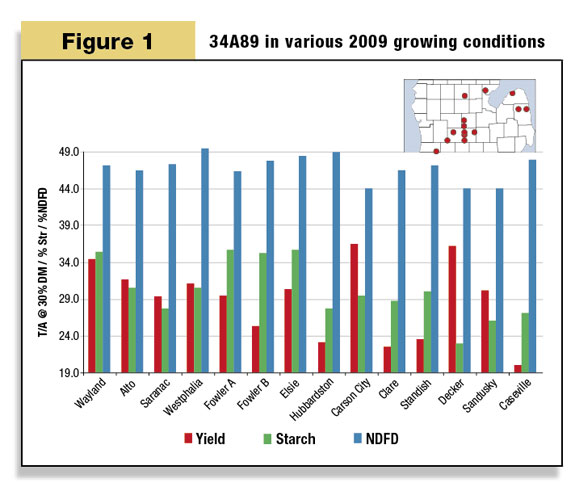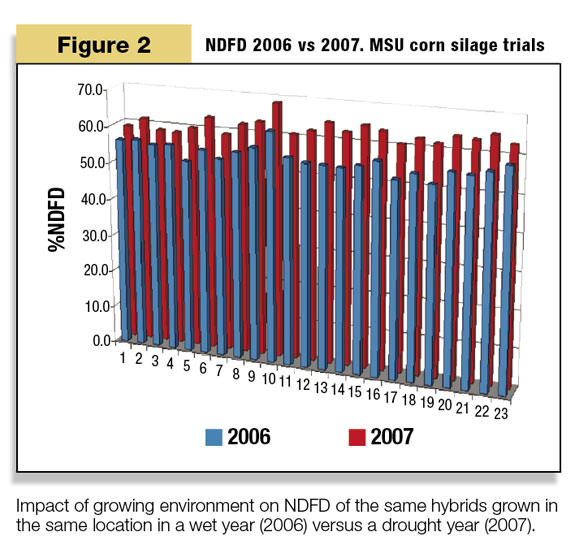It was wet, but some planting was completed with a lot of corn going in the ground from May 9 to 12. Then, the rain came.
We were rained out of fields for two weeks in some places, a month in others. These differences in planting date will have some effect on both yield and quality, but not as much as the environment that the corn encounters as it grows.
I’d like to delve in to some of the major environmental factors that determine the quality of our corn silage when we go to harvest.

The tremendous influence growing environments have on silage quality is depicted in Figure 1.
Figure 1 shows the relative silage yields, starch content and 24-hour neutral detergent fibre digestibility (NDFD) of the same hybrid grown in 14 locations in Michigan in 2009.
This figure pretty clearly shows why we cannot attribute all of the quality or yield measurements of silage to the hybrid genetics.
Environment clearly has a huge effect on both yield and quality even within a relatively small geography. Thinking back to the article in the November 2011 edition of Progressive Dairyman, this again illustrates why we can’t pick a silage hybrid based on one feed test or plot.
Researchers suggested that cool, dry years are best for corn silage quality and that slight moisture stress might stimulate grain production.
Cool temperatures, especially at night, may inhibit secondary cell wall development thereby improving digestibility.
These studies suggest that accumulated heat units after silking may be most important in affecting corn silage’s nutritive value because of the nutritional value of enhanced grain yield.
The specific timing of environmental stress during the development of the corn plant also appears to be important.
Research by Mertens indicated that the weather before and after silking may interact to affect the final corn silage nutritive value.
Mertens analyzed unfermented whole-plant corn samples from various genetics grown in multiple locations, with each location geo-referenced to allow for weather station data to be included in the analysis.
Growing conditions prior to silking affected corn plant height (and yield) and fibre digestibility, while growing conditions after silking appeared to exert a stronger effect on corn grain yield and total dry matter digestibility.

Figure 2 shows data from Michigan State University silage plots harvested in a relatively wet growing season (2006) compared to the same hybrids harvested from the same plot in a relatively dry growing season (2007).
Hybrids averaged 6.5 points higher in 24-hour NDFD in the drought year. It was interesting to note that, as expected, the highest NDFD in both seasons was a brown mid-rib (BMR) hybrid (#9), but nearly half of the conventional hybrids grown in the drought year were higher in NDFD than the BMR hybrid grown in the wet year.
This really gives us further information to support findings that some level of drought stress will in fact increase digestibility of corn silage.
From some very simple data we are able to quite clearly see the impacts that growing season can have on our corn silage quality.
At the end of the day, we have very little influence over what Mother Nature throws at us, but understanding some of these interactions allows us to make much more informed decisions when selecting hybrids and also allows some prediction of what silage will feed like before we ever harvest.
2011 was a very interesting year, across Eastern Canada in particular. Our varied planting dates and large differences in weather across the board have resulted in some very interesting silage analysis coming back.
Overall, I would say that I have been pleasantly surprised by many of the samples that I have seen.
Starch levels are slightly lower, but comparable to 2010, digestibility has generally been higher and yields, although lower, are still above average when we look back at the last 10 years.
Quality of corn silage overall in 2011 seems to be very good and by all indications is feeding out well as we look to 2012.
No matter what the environment deals us, hybrid selection, fertility, planting date and management are all very critical parts to making high-quality forages on our dairy operations.
Remember that we grow corn silage for energy. Maximizing yield, starch and digestibility, in that order, off of every acre of land is critical. Control what we can control and don’t worry too much about the weather because we can’t change it anyway. PD
References omitted due to space, but available upon request. Click here to email an editor.

- Robert Larmer
- Consultant
- Pioneer Hi-Bred International – Canada









